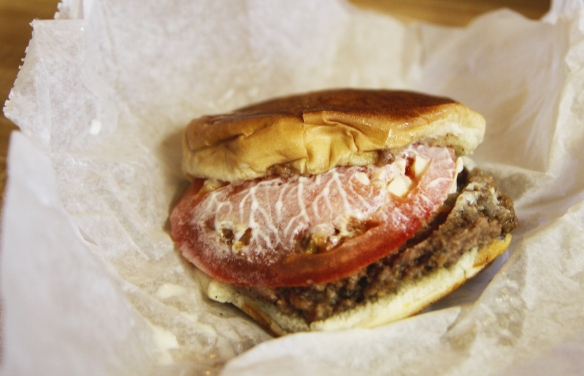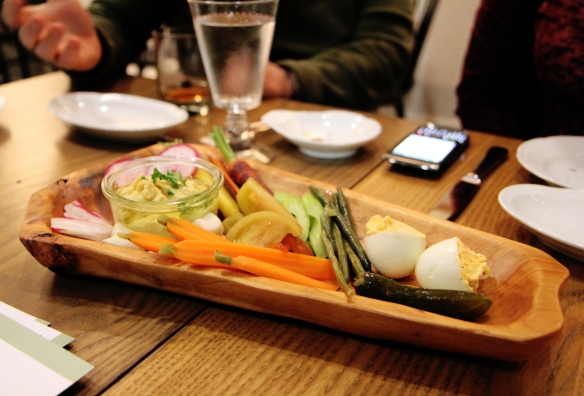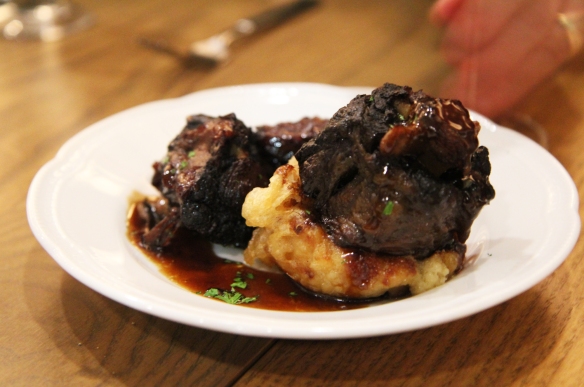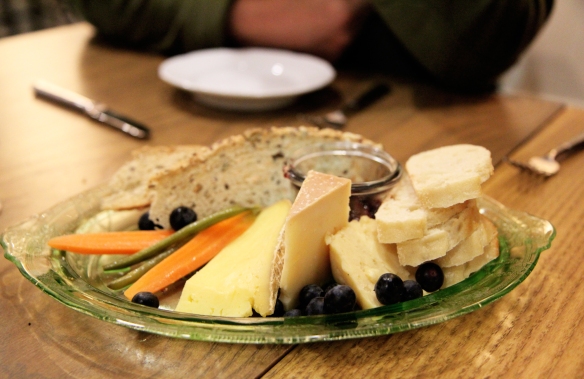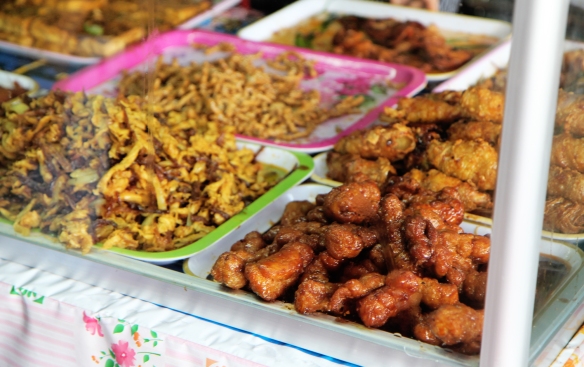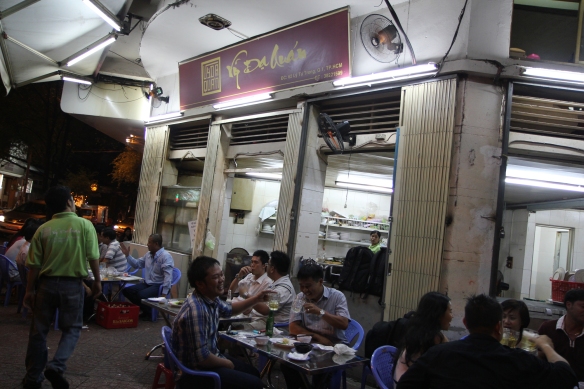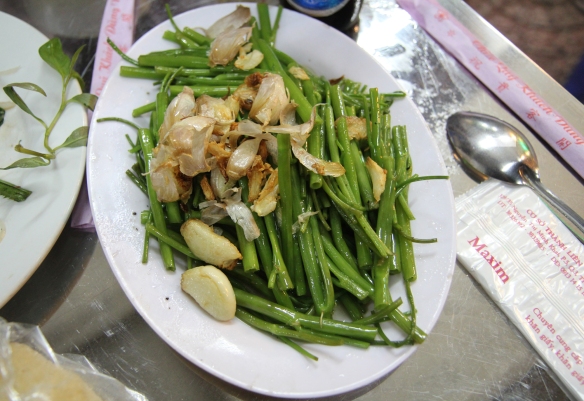Washington DC is lamentably short of half-decent Thai restaurants, but there is one exception: Little Serow.
Little Serow is a curious beast, a fixed-menu walk in restaurant that serves intensely authentic Isan-style Thai food to a decidely chic audience. It is apparently owned by a husband-wife team of Westerners who went to Thailand, liked the food, learned how to cook it, and opened a restaurant.
This therefore almost falls into the genre of Nostalgic Anthropology Restaurants, which actually tend to be quite good in my experience.
The dining room is dark and colored a minty green one usually associates with bubblegum: there are no Thai antiques or plinky traditional music in evidence. Walk-ins only: expect to wait for you seat if it isn’t a weekend, standing around among the Converse-wearing crowd.
Little Serow also isn’t particularly cheap: about $45 a person for the fixed menu. A good deal in DC, a bit horrifying for me as I got used to spending up to $2 a plate for the same stuff whilst living in Cambodia.
However, the ingredients are more expensive here and few people know how to make this stuff, so I’d be a jerk to begrudge them. The wine list is quite excellent. I suggest prosecco or another kind of sparkler. Prosecco works with really pungent Thai food, as it tuns out. Same reason it works with caviar, I guess.
Little Serow’s pretense and coolness would be tiresome as hell, but as it turns out, the food is pretty great. I haven’t had flavors like this since I was last in Northern Thailand and Cambodia – in fact, I’ve never had Thai food like this in the USA at all.

Oh god, I’m so glad pork rinds are becoming cool again. I ate a ton of them as a little kid – BBQ flavor, the only kind that would do – and was so happy to arrive in Southeast Asia and realize people loved them there too. This would be the Isan equivalent of chips and salsa while watching the game with your boys: pork rinds dipped into a smoky, spicy eggplant dip. I could eat this all day.
Pork rinds are good for you. They’re low carb. Look it up. Pigs aren’t made of carbohydrates.

Glass noodle salad with lime, chili, peanuts, cilantro, and mint. This is a pretty typical, refreshing salad in Southeast Asia – something people eat riffs on in Cambodia a lot, too.
Herbaceous and refreshing, the sort of thing you could deign to languidly consume on one of those 102-in-the-shade-with-humidity-goddammit days that both Washington DC and Thailand are prone to. Little dried shrimps abound.
I should mention that if you are allergic to shrimp, don’t eat here. Just avoid Southeast Asia, really. Especially Cambodia. That’s a good way to die. (My aunt managed it, but I made sure I knew the Khmer for “IF MY AUNT EATS SHRIMP SHE WILL DIE” with accompanying knife-across-the-throat hand signal just in case!)

Now this is something you’ve probably never had before – fried rice cakes in a pungent, hot and sour lime juice and chili dressing with mint, cilantro, shallot, and I think a touch of lemongrass. As it turns out, fried rice cakes soaked in lime take on this almost chicken-nugget like texture that is rather addictive, almost meaty. A good choice for the vegetarian who occasionally feels pangs of remorse. Pungent, crunchy.
I should add I don’t find the food at Little Serow all that spicy. However, my friends claim I fried off all my tastebuds in a childhood accident so you might want to tread cautiously.

This is a Isan-style salad with ground catfish, basil, dill, lime juice, mint, chili, fried shallot, fresh shallot, and probably other spices I’m forgetting. I happen to be a big catfish fan – blame it on the Southern genes – and Southeast Asia is in fervent agreement. Also, catfish get big enough to devour smallish people (like myself) in the Mekong, so my sympathy for the bewhiskered, muddy bastards is minimal.
Ground catfish happens to be fantastic, especially when combined with a lot of pungent spices and eaten out of lettuce cups. I wish I could order this up for lunch. It’s somewhat like a larb gai salad with catfish, by ways of comparison. My favorite dish at Little Serow. Am having occasional dreams of making it myself. Of course, I must first grind a catfish.

Chinese broccoli with fried s,melts in an oyster sauce. I love Chinese broccoli in oyster sauce, to an extent that many people find somewhat confusing as most people would probably not regard a cruciferous vegetable tantamount to, say, miniature buttercream cupcakes with likkle sugar heart on them. But love it I do. I especially love it if you put much misunderstood and delightful fried smelts on top of em’. Just eat the heads, they won’t kill you, you weenie. Full of calcium. And eyeballs. Those too. 
Charcoal glazed pork-rib with onions and dill in a semi-sweet chili sauce. This is the dish everyone lauds at Little Serow, apparently, and it’s definitely pretty good. Certainly reminiscent of stuff I’ve eaten from smoky, late-night meat stalls in Cambodia and Thailand, sexed up a bit. (It would be difficult to secure a license for a whole pig food truck here in Washington, I wager, though I am also 99% certain some clever little shit has made the attempt).
Nice and tender meat, although I actually prefer it a little chewier. But that is a truly minor complaint on my end.
Dill is not something we associate with grilling too much in the USA – most of us restrict its use to salmon and perhaps Green Goddess dressing – but it happens to be insanely popular in Vietnam, and widely used elsewhere in Southeast Asia.
Ok, so what exactly differentiates Isan food from the stuff you might reasonably encounter at a mall Thai-food stand? Well, Isan food is heavily influenced by the pungent, herb-filled cuisines of Laos and Cambodia, and that’s definitely in evidence at Little Serow, where every dish is full of vibrant, occasionally challenging flavors that rarely get much air-time in trendy US restaurants.
Americans for some reason don’t really go in for Eau de Aged, Pungent Fish Mashed With Chilis and Tiny Little Bones. Shocker. (This is not something you would be served at Little Serow, relax).
Isan food is also known for being even spicier than the Bangkok-style Thai food we usually encounter in the USA, which is really a feat, as Thai food in Bangkok can easily be blow-the-roof off hot if you ask nicely. I know that the only time in my life I have thought food was going to actually kill me occurred when I unthinkingly told a little old Lao lady at a Bangkok food stand to “make my papaya salad spicy.” Jesus God.
Yelp seems to indicate that a lot of people try this place out and fail to get it, but I’m happy to admit that this is not among the easiest cuisines in the world to fall in love with – pungent, spicy, just-plain-weird flavors are the order of the day. Don’t go in expecting to order chicken pad thai, in other words. Not that there’s anything wrong with that venerable, delicious dish.
I have a lot of beef with people who desperately attempt to find THE MOST AUTHENTIC version of whatever cuisine. Authenticity is nice and all, but in the case of, say, Isan style food, Really Authentic usually involves a lot more wild frog, insects, and breaches of hygiene. (I won’t get into what REALLY AUTHENTIC Khmer food as served through a US lens might be like). Taste should really be everything. I can appreciate Little Serow, but I can also appreciate a dynamite chicken pad thai.






